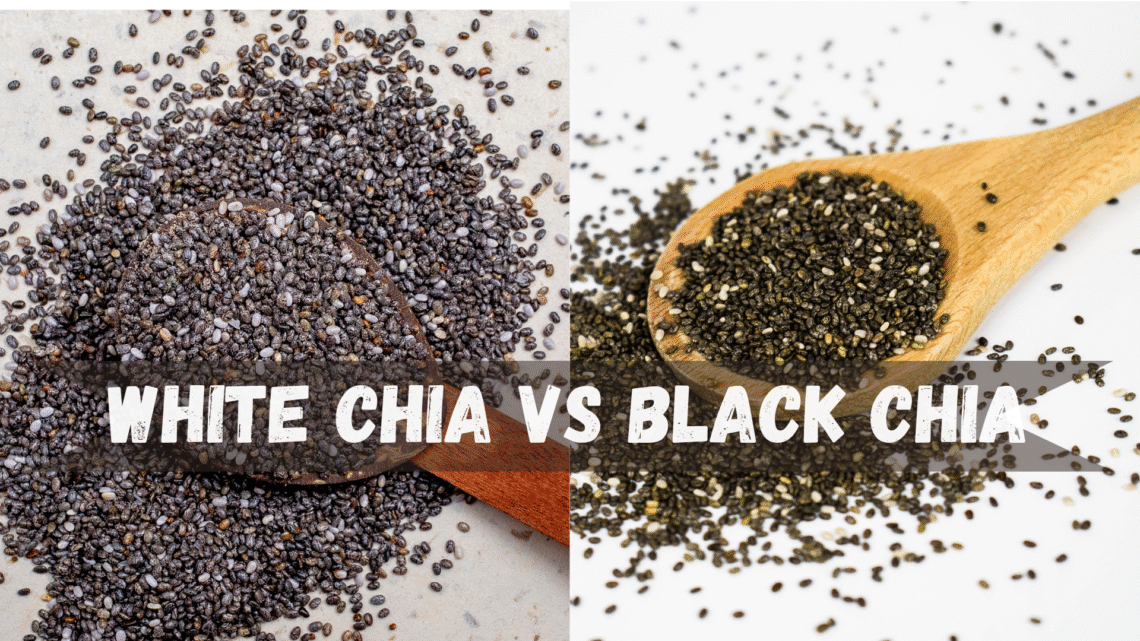Chia seeds have gained popularity in the health world as a nutritional powerhouse. Rich in omega-3 fatty acids, fiber, antioxidants, and protein, these tiny seeds are a staple for many health-conscious eaters. But a common question arises: White Chia vs Black Chia – is one superior to the other? Though both varieties originate from the same plant species, Salvia hispanica, they differ slightly in a few key areas. In this blog, we dive into five major distinctions between White Chia vs Black Chia, helping you choose the right type for your lifestyle.
5 Key Differences b/w White vs Black Chia
1. Visual Differences

The most noticeable difference in the White Chia vs Black Chia discussion is their appearance.
- White Chia: These seeds are pale in color, ranging from off-white to light gray. They blend better with lighter foods like yogurt and smoothies.
- Black Chia: Typically darker, with a deep brown or black hue, they stand out more in recipes.
Although the color difference doesn’t impact the nutritional value or flavor, it can influence how your final dish looks.
2. Nutritional Value Comparison

Nutritionally, both types of chia seeds are powerhouses and share almost identical profiles. However, subtle differences have been noted in various studies.
- Omega-3 Content: White chia seeds might offer slightly higher amounts of ALA, a form of omega-3.
- Protein Levels: Black chia seeds may have a tiny edge in protein content.
- Fiber: Both contain similar levels of fiber, around 10 grams per ounce.
Nutritional Snapshot per 28g:
| Nutrient | White Chia | Black Chia |
| Calories | 137 | 138 |
| Fiber | 10.6g | 10.1g |
| Omega-3 (ALA) | 5.3g | 5.0g |
| Protein | 4.4g | 4.7g |
In summary, there are only negligible nutritional differences between White Chia vs Black Chia.
3. Farming Practices and Market Presence

When comparing White Chia vs Black Chia, one factor to consider is availability.
- Black Chia: Grown more abundantly across the globe, especially in regions like Mexico, Bolivia, and Australia. Easily found and usually priced lower.
- White Chia: Harvested from selective plants to maintain their light color, making them a rarer find in stores.
Due to lower supply and more selective harvesting, white chia seeds often come with a higher price tag.
4. Culinary Flexibility

Both types of chia seeds are extremely versatile, yet the visual aspect often influences which one is used in certain dishes.
- White Chia: Ideal for light-colored meals like vanilla chia pudding, almond milk smoothies, or pale desserts.
- Black Chia: Best used in hearty recipes such as granola bars, oatmeal, and whole-grain breads.
Regardless of color, both varieties develop a gel-like consistency when soaked in liquid, making them useful in vegan recipes and hydration beverages.
Top Uses for Chia Seeds:
- Pudding with plant-based milk
- Nutrient-rich smoothies
- Chia egg replacement in vegan baking
- Energy-packed bars
- Detox water infusions
5. Shelf Stability and Storage Guidelines

In the White Chia vs Black Chia debate, shelf life isn’t a distinguishing factor. Both have similar storage needs and longevity.
- Shelf Life: When kept in the right conditions, chia seeds can remain fresh and usable for up to two years.
- Storage Recommendations: Keep in an airtight container in a cool, dark place
Thanks to their high antioxidant content, both types resist spoilage well and remain fresh for long periods.
Bonus Insight: What Should Influence Your Choice?
The White Chia vs Black Chia decision often comes down to personal preference and aesthetics. If you’re concerned about presentation, white chia may be more visually suitable. If budget and accessibility are more important, black chia is likely your go-to.
Health-wise, both provide an array of benefits:
- Promote heart health
- Aid digestion
- Support weight management
- Offer antioxidant protection
Choosing either variety means adding powerful nutrition to your daily meals.
Ultimately, in the comparison of White Chia vs Black Chia, there’s no clear winner. Both provide robust health benefits, similar nutrients, and exceptional versatility in the kitchen. Let your cooking needs, aesthetic preference, and budget guide your decision. Whichever you choose, you’re making a smart, healthy addition to your diet.
FAQ’s
Is one type of chia seed better for health than the other?
Both are equally nutritious, with very minimal differences that don’t significantly impact health outcomes.
Can I swap white chia for black chia in recipes?
Yes, they are interchangeable in all recipes.
Where can I buy them?
Available at health stores, organic sections in supermarkets, and various online retailers.
Have you experimented with both white and black chia seeds? Share your experience in the comments. If you found this comparison on White Chia vs Black Chia helpful, don’t forget to share it with friends and family!








Leave a Comment